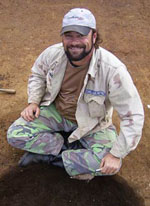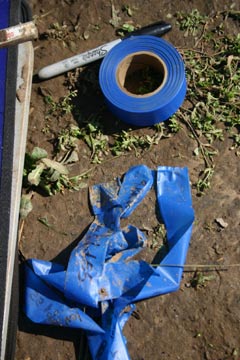- Home page
- What were you doing out there on Highway 61?
- Why did you dig there?
- Where is the site?
- Who lived there?
- What happens after the digging?
- What is archaeology?
- What is it like to work on a field crew?
- What is it like to work in the lab?
- Are there laws that protect archaeological sites?
- Ask a Native American about tribal history, archaeology, and more
- Who can I contact for more information?
- Special pages for students
- Special pages for teachers
- Special pages for archaeologists
Crew journal
A day at work on the Leake Site
by J. T. Patton
Archaeological Technician
 Your alarm rings at 6:00 a.m. at the crew house. You and your roommates, who are also co-workers, begin to stir. There is much to be done. You prepare breakfast and a sack lunch, fill a thermos, fill your canteens with water, check your excavation gear, check your clipboard for necessary paperwork and of course, check with the meteorologists to make sure you have on enough layers of insulation. It’s going to be another windy one.
Your alarm rings at 6:00 a.m. at the crew house. You and your roommates, who are also co-workers, begin to stir. There is much to be done. You prepare breakfast and a sack lunch, fill a thermos, fill your canteens with water, check your excavation gear, check your clipboard for necessary paperwork and of course, check with the meteorologists to make sure you have on enough layers of insulation. It’s going to be another windy one.
The crew assembles outside the field office at 8:00. Scot Keith, the co-Principal Investigator, outlines the work goals for the day. Today, there are three 2x2 meter excavation units open. Excavation needs to proceed on them. There are bucketfuls of soil from yesterday’s digging that need to be waterscreened. There are big trays of waterscreened artifacts that need to be separated. Two of the crew stay to screen and sort. You and the other three take the truck down to the plowed field where the excavation units are covered with plastic.
The main adversary of this excavation is the weather. The Leake site is in silty loam and silty clay; rich, dense soil deposited over a great span of time by the Etowah River. The soil doesn’t drain rapidly. When it is waterlogged, it becomes both sticky and slippery. When baked too dry by the sun, it concretes and becomes impossible to excavate. When you remove the plastic cover, you are relieved to see that the floor of the excavation unit is just wet enough to dig properly.
After arranging your clipboard, thermos, and tools within reach and sharpening the blade of your flat shovel with a file, you carefully step down into the square excavation unit. The southwest corner is the datum. There is a stake with a string tied to it. You put a line level on the string and pull it tight. The distance from the string to the floor gives the depth. You take several measurements in different areas to make sure the floor is level. Then you begin in one corner, slicing thin strips of soil, just scraping it with the shovel. When it’s right it peels like cheese. It looks like dark chocolate. You are excavating in a very rich garbage midden from the Middle Woodland Period. People lived in this exact spot for untold numbers of generations. The soil has preserved a detailed record of their various lives. It’s your job to document it well.
You shovel the sliced midden soil into a bucket. The bucket has a label on the handle telling where the soil came from, and an identical label down in the soil for insurance. The full buckets go up to the field office to be water screened through a fine mesh. You also take soil samples and bag them up from each level in the floor. As you are scraping, you keep an eye out for large chunks of charcoal, broken hearth rocks, pottery sherds, stone tools and projectile points, animal bone, teeth and other artifacts. The concentrations and locations of these artifacts are as important to our study as the items themselves. As you scrape the soil, you notice a slight change in the texture. Looking closer, you see a subtle but distinct change in the color. You put down the shovel and pick up the trowel. Crouching and scraping, you reveal a perfectly round dark stain within the midden. This is likely a postmold, or a stain resulting from a post rotting in place. When you find several in a line or a semi-circle, you have begun to pinpoint the former location of a structure. Unfortunately, over the centuries new structures weren’t built in exactly the same places as the older ones, so your midden contains a jumble of postmolds overlapping in space and time. That is why you document the size and depth of each postmold carefully.
You also keep a large rubber band over your forms and field notes to keep them secure from the late winter wind. Between the wind, the heavy traffic on the nearby highway, and the regular freight trains on the nearby rail, you and your crewmates sometimes have to yell to communicate. By lunch break, you have uncovered another postmold and a larger pit feature, and you have photographed and drawn them to scale.
Lunch is the chance to get in out of the wind and find out what has been discovered at other areas of the site. Every day brings more data to add to the big picture, but “a dozen new questions ride in on the coat-tail of every answer.”
You spend the afternoon bisecting the postmold and pit feature, taking special samples of the soils for pollen and phytolith (silica walls of plant cells) studies, first making sure you clean your trowels well with distilled water. The various samples taken for things we cannot see with our bare eyes may be the most important things that we remove from this soil. Everything you do must be carefully documented, so a lot of your afternoon’s work is making sure your forms, notes and labels are accurate and understandable, but you also move a fair amount of soil around, too.
Before you know it, it is time to pack up for the day. You help cover the excavation units securely for the night, then pack the equipment and artifacts into a big steel vault for safekeeping. You pass the security guard, just coming on duty. On the drive home, you imagine a world without cars or even horses, where you walked or paddled a canoe everywhere. You wonder what the Middle Woodland people who lived here 2,000 years ago are going to tell you about that world tomorrow.


